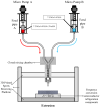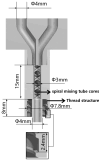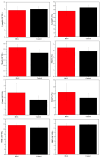Research on Dual-Phase Composite Forming Process and Platform Construction of Radial Gradient Long Bone Scaffold
- PMID: 39329610
- PMCID: PMC11428698
- DOI: 10.3390/bioengineering11090869
Research on Dual-Phase Composite Forming Process and Platform Construction of Radial Gradient Long Bone Scaffold
Abstract
The structure and composition of natural bone show gradient changes. Most bone scaffolds prepared by bone tissue engineering with single materials and structures present difficulties in meeting the needs of bone defect repair. Based on the structure and composition of natural long bones, this study proposed a new bone scaffold preparation technology, the dual-phase composite forming process. Based on the composite use of multiple biomaterials, a bionic natural long bone structure bone scaffold model with bone scaffold pore structure gradient and material concentration gradient changes along the radial direction was designed. Different from the traditional method of using multiple nozzles to achieve material concentration gradient in the scaffold, the dual-phase composite forming process in this study achieved continuous 3D printing preparation of bone scaffolds with gradual material concentration gradient by controlling the speed of extruding materials from two feed barrels into a closed mixing chamber with one nozzle. Through morphological characterization and mechanical property analysis, the results showed that BS-G (radial gradient long bone scaffolds prepared by the dual-phase composite forming process) had obvious pore structure gradient changes and material concentration gradient changes, while BS-T (radial gradient long bone scaffolds prepared by printing three concentrations of material in separate regions) had a discontinuous gradient with obvious boundaries between the parts. The compressive strength of BS-G was 1.00 ± 0.19 MPa, which was higher than the compressive strength of BS-T, and the compressive strength of BS-G also met the needs of bone defect repair. The results of in vitro cell culture tests showed that BS-G had no cytotoxicity. In a Sprague-Dawley rat experimental model, blood tests and key organ sections showed no significant difference between the experimental group and the control group. The prepared BS-G was verified to have good biocompatibility and lays a foundation for the subsequent study of the bone repair effect of radial gradient long bone scaffolds in large animals.
Keywords: bone scaffold; continuous printing; radial gradient tapering.
Conflict of interest statement
On behalf of all authors, the corresponding author states that there are no conflicts of interest.
Figures
















Similar articles
-
Morphological Integrated Preparation Method and Implementation of Inorganic/Organic Dual-Phase Composite Gradient Bionic Bone Scaffold.3D Print Addit Manuf. 2024 Apr 1;11(2):e607-e618. doi: 10.1089/3dp.2022.0111. Epub 2024 Apr 16. 3D Print Addit Manuf. 2024. PMID: 38689928
-
[CYTOCOMPATIBILITY AND PREPARATION OF BONE TISSUE ENGINEERING SCAFFOLD BY COMBINING LOW TEMPERATURE THREE DIMENSIONAL PRINTING AND VACUUM FREEZE-DRYING TECHNIQUES].Zhongguo Xiu Fu Chong Jian Wai Ke Za Zhi. 2016 Mar;30(3):292-7. Zhongguo Xiu Fu Chong Jian Wai Ke Za Zhi. 2016. PMID: 27281872 Chinese.
-
3D-printed poly(Ɛ-caprolactone) scaffold with gradient mechanical properties according to force distribution in the mandible for mandibular bone tissue engineering.J Mech Behav Biomed Mater. 2020 Apr;104:103638. doi: 10.1016/j.jmbbm.2020.103638. Epub 2020 Jan 14. J Mech Behav Biomed Mater. 2020. PMID: 32174396
-
Three-dimensional (3D) printed scaffold and material selection for bone repair.Acta Biomater. 2019 Jan 15;84:16-33. doi: 10.1016/j.actbio.2018.11.039. Epub 2018 Nov 24. Acta Biomater. 2019. PMID: 30481607 Review.
-
Gradient scaffolds for osteochondral tissue engineering and regeneration.J Mater Chem B. 2020 Sep 23;8(36):8149-8170. doi: 10.1039/d0tb00688b. J Mater Chem B. 2020. PMID: 32776030 Review.
References
-
- Song Y., Hu Q., Liu Q., Liu S., Wang Y., Zhang H. Design and fabrication of drug-loaded alginate/hydroxyapatite/collagen composite scaffolds for repairing infected bone defects. J. Mater. Sci. 2023;58:911–926. doi: 10.1007/s10853-022-08053-3. - DOI
-
- Zhang Y., Liu X., Zeng L., Zhang J., Zuo J., Zou J., Ding J., Chen X. Polymer Fiber Scaffolds for Bone and Cartilage Tissue Engineering. Adv. Funct. Mater. 2019;29:1903279. doi: 10.1002/adfm.201903279. - DOI
Grants and funding
LinkOut - more resources
Full Text Sources
Miscellaneous

